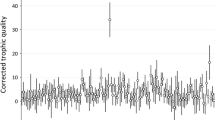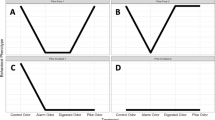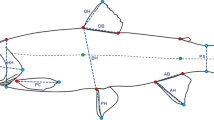Abstract
Traditionally, convergent evolution has been considered to produce phenotypic similarity in independently evolved species. By contrast, recent studies have detected morphological divergence between species even in similar selective environments when different morphological traits combine to produce a specific functional output. However, it is still unclear whether a complex combination of non-morphological phenotypic traits, such as behavioural and life-history traits, can produce a similar performance in different species. In this study, I examined prey capture performance and related phenotypes in two sympatric ladybird species, Sospita oblongoguttata and Harmonia yedoensis, which specialize on the giant pine aphid, which is known to be elusive for ladybird hatchlings. In particular, I focused on egg size and proportion of trophic eggs in the clutch, since the amount of maternal investment per offspring can contribute to prey capture performance of ladybird hatchlings. Predation success of hatchlings against the giant pine aphid was higher in both S. oblongoguttata and H. yedoensis than in Harmonia axyridis, a generalist ladybird species that feeds on various kinds of aphid species in nature. Sospita oblongoguttata females, however, produced relatively larger eggs and in most clutches provided no trophic eggs, whereas H. yedoensis females produced smaller eggs and provided more trophic eggs per clutch. Moreover, hatchling morphology in H. yedoensis more closely resembled that of its congener, H. axyridis, than that of the more distantly related S. oblongoguttata, although like H. yedoensis, S. oblongoguttata predates on the elusive pine aphid. These results in two pine-associated specialist ladybirds indicate that divergent phenotypes can nonetheless have similar prey capture performance. In conclusion, this work demonstrates that the general ultimate function can be achieved by various mechanisms through convergence that operates at different level of life.





Similar content being viewed by others
References
Alfaro ME, Bolnick DI, Wainwright PC (2004) Evolutionary dynamics of complex biomechanical systems: an example using the four-bar mechanism. Evolution 58:495–503
Bates D, Maechler M, Bolker B et al (2015) Fitting linear mixed-effects models using lme4. J Stat Soft 67:1–48
Baur B (1990) Possible benefits of egg cannibalism in the land snail Arianta arbustorum (L.). Funct Ecol 4:679–684
Blob RW, Rai R, Julius ML et al (2006) Functional diversity in extreme environments: effects of locomotor style and substrate texture on the waterfall-climbing performance of Hawaiian gobiid fishes. J Zool 268:315–324
Collar DC, Wainwright PC (2006) Discordance between morphological and mechanical diversity in the feeding mechanism of centrarchid fishes. Evolution 60:2575–2584
Crespi BJ (1992) Cannibalism and trophic egg in subsocial and eusocial insects. In: Elgar MA, Crespi BJ (eds) Cannibalism: ecology and evolution among diverse taxa. Oxford University Press, New York, pp 176–213
Dixon AFG (2000) Insect predator–prey dynamics: ladybird beetles and biological control. Cambridge University Press, Cambridge
Edgar RC (2004) MUSCLE: multiple sequence alignment with high accuracy and high throughput. Nucleic Acid Res 32:1792–1797
Folmer O, Black M, Hoeh W et al (1994) DNA primers for amplification of mitochondrial cytochrome c oxidase subunit I from diverse metazoan invertebrates. Mol Mar Biol Biotech 3:294–299
Foote M (1998) Contingency and convergence. Science 280:2068–2069
Gaskett AC, Endler JA, Phillips RD (2017) Convergent evolution of sexual deception via chromatic and achromatic contrast rather than colour mimicry. Evol Ecol 31:205–227
Hagman M, Ord TJ (2016) Many paths to a common destination: morphological differentiation of a functionally convergent visual signal. Am Nat 188:306–318
Herrel A, Vanhooydonck B, Van Damme R (2004) Omnivory in lacertid lizards: adaptive evolution or constraint? J Evol Biol 17:974–984
Hulsey CD, Wainwright PC (2002) Projecting mechanics into morphospace: disparity in the feeding system of labrid fishes. Proc R Soc Lond B Biol Sci 269:317–326
Kaeuffer R, Peichel CL, Bolnick DI et al (2011) Parallel and nonparallel aspects of ecological, phenotypic, and genetic divergence across replicate population pairs of lake and stream stickleback. Evolution 66:402–418
Kumar S, Stecher G, Tamura K (2016) MEGA7: molecular evolutionary genetics analysis version 7.0 for bigger datasets. Mol Biol Evol 33:1870–1874
Langerhans RB, DeWitt TJ (2004) Shared and unique features of evolutionary diversification. Am Nat 164:335–349
Leinonen T, McCairns RJ, Herczeg G et al (2012) Multiple evolutionary pathways to decreased lateral plate coverage in freshwater threespine sticklebacks. Evolution 66:3866–3875
Losos JB (2011) Convergence, adaptation, and constraint. Evolution 65:1827–1840
Lucas E (2005) Intraguild predation among aphidophagous predators. Eur J Entomol 102:351–364
Madison WP, Madison DR (2017) Mesquite: a modular system for evolutionary analysis. Version 3.2. Available from http://mesquiteproject.org (accessed August 2017)
Magro A, Lecompte E, Magné F et al (2010) Phylogeny of ladybirds (Coleoptera: Coccinellidae): are the subfamilies monophyletic? Mol Phyl Evol 54:833–848
Maino JL, Pirtle EI, Kearney MR (2016) The effect of egg size on hatch time and metabolic rate: theoretical and empirical insights on developing insect embryos. Funct Ecol 31:227–234
Majerus MEN (1994) Ladybirds. Harper Collins, London
Marks CO, Lechowicz MJ (2006) Alternative designs and the evolution of functional diversity. Am Nat 167:55–66
Mayr E (1963) Animal species and evolution. Belknap Press of Harvard University Press, Cambridge
McGee MD, Wainwright PC (2013) Convergent evolution as a generator of phenotypic diversity in threespine stickleback. Evolution 67:1204–1208
Noriyuki S, Osawa N (2016) Reproductive interference and niche partitioning in aphidophagous insects. Psyche Article ID 4751280
Noriyuki S, Osawa N, Nishida T (2011) Prey capture performance in hatchlings of two sibling Harmonia ladybird species in relation to maternal investment through sibling cannibalism. Ecol Entomol 36:282–289
Noriyuki S, Kawatsu K, Osawa N (2012) Factors promoting maternal trophic egg provisioning in non-eusocial animals. Popul Ecol 54:455–465
Noriyuki S, Kameda Y, Osawa N (2014) Prevalence of male-killer in a sympatric population of two sibling ladybird species, Harmonia yedoensis and Harmonia axyridis (Coleoptera: Coccinellidae). Eur J Entomol 111:307–311
Noriyuki S, Suzuki-Ohno Y, Takakura KI (2016) Variation of clutch size and trophic egg proportion in a ladybird with and without male-killing bacterial infection. Evol Ecol 30:1081–1095
Osawa N, Ohashi K (2008) Sympatric coexistence of sibling species Harmonia yedoensis and H. axyridis (Coleoptera: Coccinellidae) and the roles of maternal investment through egg and sibling cannibalism. Eur J Entomol 105:445–454
Pentinsaari M, Hebert PDN, Mutanen M (2014) Barcoding beetles: a regional survey of 1872 species reveals high identification success and unusually deep interspecific divergences. PLoS ONE 9:e108651
Perry JC, Roitberg BD (2006) Trophic egg laying: hypotheses and tests. Oikos 112:706–714
Rambaut A, Suchard M, Drummond A (2013) Tracer 1.6. Available from http://tree.bio.ed.ac.uk/software/tracer/. Accessed Aug 2017
Ronquist F, Huelsenbeck JP (2003) MrBayes 3: Bayesian phylogenetic inference under mixed models. Bioinformatics 19:1572–1574
Rosenblum EB (2006) Convergent evolution and divergent selection: lizards at the White Sands ecotone. Am Nat 167:1–15
Rosenblum EB, Parent CE, Brandt EE (2014) The molecular basis of phenotypic convergence. Ann Rev Ecol Evol Syst 45:203–226
Roy H, Brown P, Frost R et al (2011) Ladybirds (Coccinellidae) of Britain and Ireland. Centre for Ecology and Hydrology, Oxfordshire
Sasaji H (1998) Tentoumushi no shizenshi (Natural history of the ladybirds). University of Tokyo Press, Tokyo
Simpson GG (1953) The major features of evolution. Columbia University Press, New York
Speed MP, Arbuckle K (2016) Quantification provides a conceptual basis for convergent evolution. Biol Rev 92:815–829
Stayton CT (2006) Testing hypotheses of convergence with multivariate data: morphological and functional convergence among herbivorous lizards. Evolution 60:824–841
Stayton CT (2015) The definition, recognition, and interpretation of convergent evolution, and two new measures for quantifying and assessing the significance of convergence. Evolution 69:2140–2150
Stern DL (2013) The genetic causes of convergent evolution. Nat Rev Genet 14:751–764
Takakura K (2004) Variation in egg size within and among generations of the bean weevil, Bruchidius dorsalis (Coleoptera, Bruchidae): effects of host plant quality and paternal nutritional investment. Ann Entomol Soc Am 97:346–352
Toro E, Herrel A, Irschick D (2004) The evolution of jumping performance in Caribbean Anolis lizards: solutions to biomechanical trade-offs. Am Nat 163:844–856
Wainwright PC (2007) Functional versus morphological diversity in macroevolution. Ann Rev Ecol Evol Syst 38:381–401
Wainwright PC, Alfaro ME, Bolnick DI et al (2005) Many-to-one mapping of form to function: a general principle in organismal design? Integ Comp Biol 45:256–262
Yasuda H, Evans EW, Kajita Y et al (2004) Asymmetric larval interactions between introduced and indigenous ladybirds in North America. Oecologia 141:722–731
Young RL, Haselkorn TS, Badyaev AV (2007) Functional equivalence of morphologies enables morphological and ecological diversity. Evolution 61:2480–2492
Young RL, Sweeney MJ, Badyaev AV (2010) Morphological diversity and ecological similarity: versatility of muscular and skeletal morphologies enables ecological convergence in shrews. Funct Ecol 24:556–565
Acknowledgements
I am grateful to Erica Bree Rosenblum and Seira Ashley Adams for valuable comments on the manuscript, and Yuichi Kameda and Ryutaro Goto for assistance with phylogenetic analysis. This study was supported by a Grant-in-Aid for Scientific Research (No. 26840137) from the Japan Society for the Promotion of Science.
Author information
Authors and Affiliations
Corresponding author
Electronic supplementary material
Below is the link to the electronic supplementary material.
Rights and permissions
About this article
Cite this article
Noriyuki, S. Functional convergence and phenotypic divergence in two specialist species of pine-associated ladybirds. Evol Ecol 31, 885–898 (2017). https://doi.org/10.1007/s10682-017-9918-z
Received:
Accepted:
Published:
Issue Date:
DOI: https://doi.org/10.1007/s10682-017-9918-z




